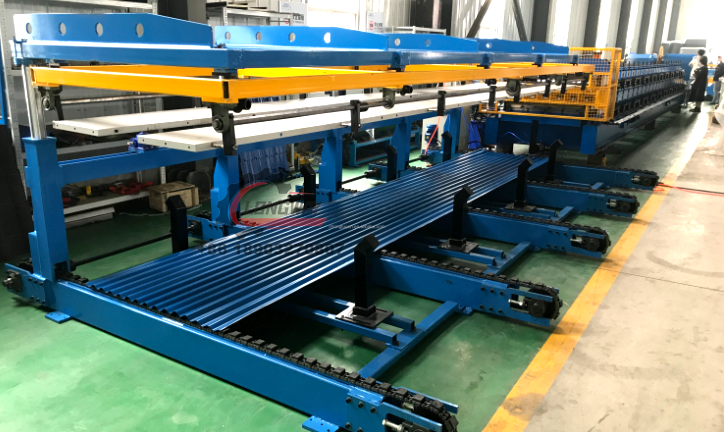Advanced CD UD CW Roll Forming Technology for Precision Metal Fabrication Solutions
Understanding CD, UD, and CW Roll Formers
In the modern manufacturing landscape, roll forming has been a pivotal process used to create complex profiles from metal sheets or strips. Among the various types of roll forming machines, the CD (C-Channel), UD (U-Channel), and CW (C-Section) roll formers stand out for their versatility and efficiency in producing a range of structural components. Understanding these machines not only highlights their unique capabilities but also emphasizes their applications in various industries, including construction, automotive, and HVAC.
What is Roll Forming?
Roll forming is a continuous bending operation where a long strip of metal is passed through a set of sequentially arranged rollers. Each pair of rollers is designed to bend the material at specific angles, gradually shaping it into the desired profile. This process is particularly advantageous for producing long lengths of materials with uniform cross-sections.
CD Roll Formers
CD roll formers are specially designed to create C-shaped sections, commonly known as C-Channel. These channels are widely used in construction and structural applications, providing support and strength to buildings and equipment. The C-shape offers excellent load-bearing capacity while being lightweight, making it a favorite among engineers and architects.
The process begins with feeding a flat metal strip into the roll former. As the metal passes through the rollers, it is gradually bent into a C-shape. The precise control of the roll forming process ensures that each C-Channel produced meets stringent quality and dimensional specifications. CD roll formers can handle various materials, including steel, aluminum, and other alloys, accommodating different thicknesses and widths as per project requirements.
UD Roll Formers
UD roll formers, on the other hand, are designed to produce U-shaped sections, often referred to as U-Channels. These sections are equally essential in the construction and manufacturing industries. The U-shape provides structural integrity and is often used for framing, bracing, and support systems.
The manufacturing process of UD roll forming follows a similar method to CD roll forming. The metal strip is fed into the machine, where rollers gradually shape it into a U-profile. The versatility of UD roll formers allows them to produce U-Channels of varying sizes and thicknesses, tailored to meet specific engineering requirements. The uniformity and strength of the produced U-Channels make them ideal for use in applications where load distribution is crucial.
cd ud cw ud roll former

CW Roll Formers
CW roll formers are used to create C-section profiles, which are crucial components in many construction applications. Like their CD and UD counterparts, CW roll formers employ a series of rollers to shape metal strips into a continuous C-section. This process is efficient and allows for customization, ensuring that the components produced fit specific project needs.
C-sections are used extensively in structural frameworks, providing essential support in buildings and other infrastructures. Their design allows for easy integration into existing structures, making CW roll formers a preferred choice for contractors and builders looking for reliable solutions.
Advantages of Roll Forming Technology
One of the key advantages of using CD, UD, and CW roll formers is the efficiency of the manufacturing process. Roll forming allows for continuous production, which significantly reduces labor costs and increases output rates. Additionally, since the process requires minimal material handling, it reduces the risk of damage to the metal sheets.
Moreover, the precision of roll forming results in consistent quality and uniformity across the produced sections. This is particularly crucial in applications that demand high structural integrity. Modern roll forming machines are equipped with advanced technology, including computer controls, which enhance precision and reduce waste.
Applications Across Industries
The applications of CD, UD, and CW roll formers extend beyond the construction industry. In automotive manufacturing, for instance, these machines help create lightweight and durable components that improve fuel efficiency and vehicle performance. In HVAC systems, roll-formed channels are used for ductwork, ensuring effective air distribution in buildings.
Conclusion
CD, UD, and CW roll formers represent the pinnacle of modern roll forming technology. Their capabilities enable the production of a diverse array of structural components that are essential in various industries. As manufacturing continues to evolve, these machines will remain integral to meeting the demands for quality, efficiency, and innovation in metal forming processes. Understanding their functions and applications can help industries harness their full potential, leading to stronger and more efficient structures worldwide.
-
Roof Panel Machines: Buying Guide, Types, and PricingNewsJul.04, 2025
-
Purlin Machines: Types, Features, and Pricing GuideNewsJul.04, 2025
-
Metal Embossing Machines: Types, Applications, and Buying GuideNewsJul.04, 2025
-
Gutter Machines: Features, Types, and Cost BreakdownNewsJul.04, 2025
-
Cut to Length Line: Overview, Equipment, and Buying GuideNewsJul.04, 2025
-
Auto Stacker: Features, Applications, and Cost BreakdownNewsJul.04, 2025
-
Top Drywall Profile Machine Models for SaleNewsJun.05, 2025








